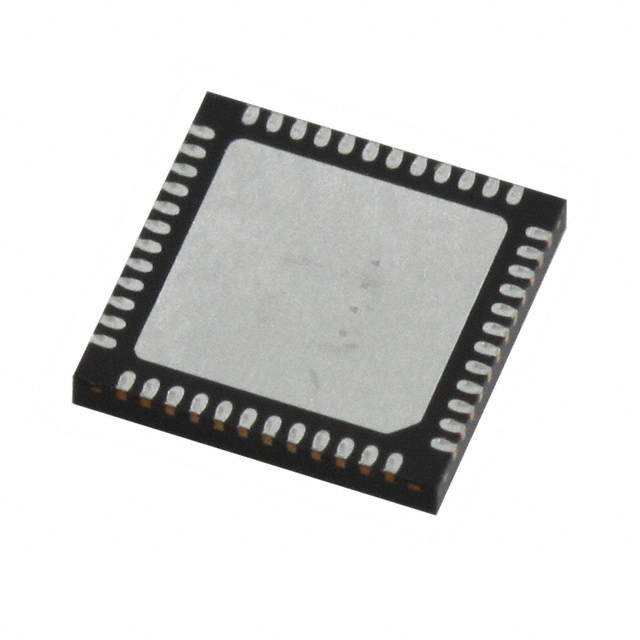CS4207-CNZ
Product Overview
- Category: Integrated Circuit (IC)
- Use: Audio Codec
- Characteristics: High-performance, low-power consumption
- Package: Compact, surface-mount package
- Essence: Provides audio input/output capabilities for electronic devices
- Packaging/Quantity: Available in reels of 2500 units
Specifications
- Power Supply Voltage: 3.3V
- Audio Resolution: Up to 24-bit
- Sampling Rate: Up to 192 kHz
- Digital Interfaces: I2S, AC'97, PCM
- Operating Temperature Range: -40°C to +85°C
Detailed Pin Configuration
The CS4207-CNZ features a total of 48 pins, each serving a specific function. The pin configuration is as follows:
- VDDA
- VSSA
- AVDD
- AGND
- DVDD
- DGND
- MCLK
- BCLK
- LRCLK
- SDIN
- SDOUT
- RESET
- GPIO1
- GPIO2
- GPIO3
- GPIO4
- GPIO5
- GPIO6
- GPIO7
- GPIO8
- GPIO9
- GPIO10
- GPIO11
- GPIO12
- GPIO13
- GPIO14
- GPIO15
- GPIO16
- GPIO17
- GPIO18
- GPIO19
- GPIO20
- GPIO21
- GPIO22
- GPIO23
- GPIO24
- GPIO25
- GPIO26
- GPIO27
- GPIO28
- GPIO29
- GPIO30
- GPIO31
- GPIO32
- GPIO33
- GPIO34
- GPIO35
- GPIO36
Functional Features
- High-quality audio playback and recording capabilities
- Support for multiple digital audio interfaces
- Low power consumption for extended battery life
- Integrated headphone amplifier for improved audio output
- Flexible GPIO pins for additional functionality
- Built-in reset functionality for easy system integration
Advantages and Disadvantages
Advantages: - High-performance audio codec - Wide range of supported digital interfaces - Compact package size for space-constrained designs - Low power consumption for energy-efficient devices
Disadvantages: - Limited number of GPIO pins - May require additional external components for certain applications - Higher cost compared to lower-end audio codecs
Working Principles
The CS4207-CNZ operates by converting analog audio signals into digital data and vice versa. It utilizes advanced signal processing algorithms to ensure high-fidelity audio reproduction. The integrated headphone amplifier enhances the audio output quality, while the flexible GPIO pins allow for customization and integration with other system components.
Detailed Application Field Plans
The CS4207-CNZ is widely used in various electronic devices that require audio input/output capabilities. Some common application fields include:
- Mobile phones and tablets
- Portable media players
- Personal computers and laptops
- Automotive infotainment systems
- Home theater systems
- Gaming consoles
- Professional audio equipment
Alternative Models
For those seeking alternative options, the following audio codecs can be considered:
- CS4270-CZZ: Similar features and performance, different pin configuration
- WM8731LSEFL/RV: Lower cost, slightly reduced audio resolution
- MAX9867ETG+: Higher audio resolution, larger package size
These alternatives provide similar functionalities and can be suitable replacements depending on specific requirements.
In conclusion, the CS4207-CNZ is a high-performance audio codec IC that offers excellent audio input/output capabilities for various electronic devices. Its compact size, low power consumption, and support for multiple digital interfaces make it a popular choice in the industry. While it has some limitations, its advantages outweigh the disadvantages, making it a reliable solution for audio processing needs.
10個與CS4207-CNZ在技術方案中應用相關的常見問題與解答
Sure! Here are 10 common questions and answers related to the application of CS4207-CNZ in technical solutions:
Q: What is CS4207-CNZ?
A: CS4207-CNZ is a technical solution course that focuses on applying computer science principles to real-world problems.Q: How can CS4207-CNZ be applied in technical solutions?
A: CS4207-CNZ can be applied by using various programming languages, algorithms, and data structures to develop efficient and effective technical solutions.Q: What are some examples of technical solutions that can be developed using CS4207-CNZ?
A: Examples include developing software applications, designing databases, creating web-based systems, implementing machine learning algorithms, and building network infrastructure.Q: How does CS4207-CNZ help in solving technical problems?
A: CS4207-CNZ provides students with the knowledge and skills required to analyze complex technical problems, design appropriate solutions, and implement them using programming and other relevant tools.Q: Can CS4207-CNZ be used in different industries?
A: Yes, CS4207-CNZ can be applied in various industries such as healthcare, finance, e-commerce, telecommunications, and many others where technical solutions are needed.Q: What programming languages are commonly used in CS4207-CNZ?
A: Commonly used programming languages in CS4207-CNZ include Java, Python, C++, and JavaScript, among others.Q: Are there any prerequisites for taking CS4207-CNZ?
A: Prerequisites may vary depending on the institution, but typically a basic understanding of computer science fundamentals and programming concepts is recommended.Q: How can CS4207-CNZ contribute to innovation in technical solutions?
A: CS4207-CNZ equips students with problem-solving skills and encourages creative thinking, which can lead to innovative approaches in developing technical solutions.Q: Can CS4207-CNZ be applied in both small-scale and large-scale technical projects?
A: Yes, CS4207-CNZ concepts and techniques can be applied to projects of varying scales, from small prototypes to large-scale enterprise systems.Q: What career opportunities are available for individuals with knowledge of CS4207-CNZ?
A: Career opportunities include software engineer, data analyst, system architect, database administrator, network engineer, and many other roles that involve developing technical solutions.
Please note that the specific questions and answers may vary depending on the context and curriculum of the CS4207-CNZ course.


